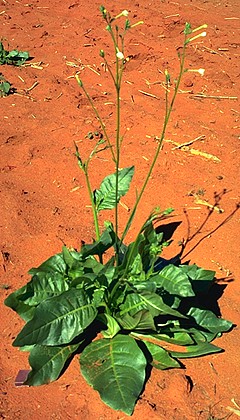
Synonymy
Nicotiana rosulata subsp. ingulba (J. Black) P. Horton, J. Adelaide Bot. Gard. 3: 33 (1981)
N. ingulba J. Black, Trans. & Proc. Roy. Soc. S. Austral. 57: 156; t. 9, fig. 1 (1933).
T: Harper's Spring, N.T., E. Kramer s.n.; holo: AD.
Description
Herb to 1 m; stems and leaves usually glabrous.
Leaves mostly radical but cauline leaves usually present, usually elliptic or the upper cauline ones lanceolate to linear, petiolate or upper cauline leaves almost sessile; lamina up to 21 cm long; petiole to 8 cm long, narrowly winged.
Inflorescence panicle-like, few-branched, variably pubescent with glandular hairs. Calyx 6–22 mm long. Corolla-tube 30–56 mm long, 1–2 mm wide at top of calyx; limb 7–25 mm diam., the lobes notched. Upper 4 anthers at the same level or 2 slightly above the other 2, the filaments to 3.5 mm long; filament of the 5th stamen 5–18 mm long, inserted in upper half of corolla-tube. Cleistogamous flowers occasionally present.
Capsule ellipsoid to narrowly ellipsoid, 6–16 mm long. Seeds usually reniform or acutely angled; testa irregularly honeycombed or wrinkled. n=20.
Distribution and ecology
Found in southern N.T. and central-eastern W.A.
Commonly grows in sandy soil in shelter of trees and often in hummock grassland.
Notes
Subsp. rosulata usually lacks cauline leaves, has a non-glandular pubescence on the lower stems and leaves and a corolla-tube usually less than 35 mm long.
Species probably most often used by the central Australian Aboriginal people as tobacco. See P. Latz, (1996). Bushfires and Bushtucker, Aboriginal Plant Use in Central Australia. IAD Press, Alice Springs, , and D. Symon (2005) Native tobaccos (Solanaceae: Nicotiana spp.) in Australia and their use by Aboriginal peoples in The Beagle 21: 1-10, for further information on this species.
According to Pandey (1969) N. rosulata has flowers which are self-compatible. Which particular subspecies was involved in these observations is unknown.
Reference: Pandey, K. K. (1969) Elements of the S-gene complex V. Interspecific cross-compatibility relationships and theory of the evolution of the S complex. Genetica 40, 447-474.
A valuable summary of the cultural use of Nicotiana species in Australia is provided in D.E.Symon (2005). Native tobaccos (Solanaceae: Nicotiana spp.) in Australia and their use by Aboriginal peoples. The Beagle 21: 1-10.
Selected specimens
W.A.: 60 km SE of Giles Meteorological Stn, A.S. George 8773 (PERTH). N.T.: Mount Wedge Stn, M. Lazarides 6060 (AD, BRI, CANB, NT); 42 km N of Barrow Creek, R.A. Perry 5338 (AD, BRI, CANB, MEL, NSW, NT).
Web links
A fact sheet for the species can be downloaded from the SA eFlora site and for the subspecies in WA can be found on the FloraBase site.







